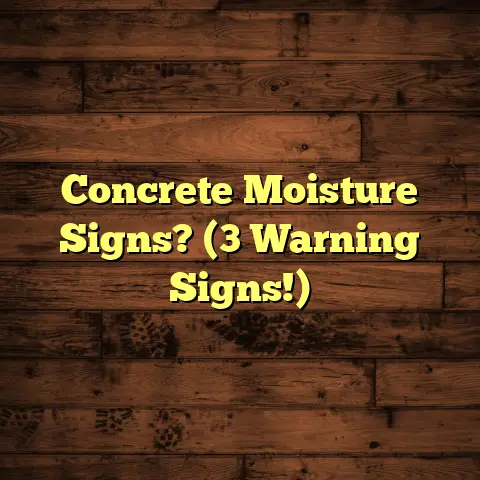DIY Epoxy Basement Floor? (3 Mistakes To Avoid!)
(3 Mistakes To Avoid!)
Have you ever glanced at your drab, cracked basement floor and envisioned transforming it into a stunning, durable surface with an epoxy finish? It’s tempting, right? But then the potential pitfalls creep in, making you feel overwhelmed. I get it! I’ve been there myself, and I’ve seen countless DIYers struggle with the same challenges.
Understanding Epoxy Flooring
So, what exactly is epoxy flooring?
Simply put, it’s a thermosetting polymer formed by mixing a resin with a hardener. This chemical reaction creates a rigid plastic material that’s incredibly strong and resistant to wear and tear.
Think of it as a super-tough coating that bonds directly to your concrete floor.
Benefits of Epoxy in Basements
Why choose epoxy for your basement? Well, the benefits are pretty compelling:
-
Durability: Epoxy floors can withstand heavy foot traffic, dropped objects, and even vehicle weight. I’ve seen epoxy floors in garages last for decades with minimal wear.
-
Aesthetic Appeal: Forget that cold, gray concrete look! Epoxy comes in a huge range of colors, patterns, and finishes. You can add metallic pigments, flakes, or even create custom designs. It’s a chance to really personalize your space.
-
Moisture Resistance: Basements are notorious for dampness. Epoxy creates a seamless, non-porous barrier that prevents moisture from seeping through the floor. This is crucial for preventing mold and mildew growth.
-
Easy to Clean: Spills and messes? No problem! Epoxy floors are incredibly easy to clean with just soap and water. No more scrubbing endlessly to remove stains.
The rise in DIY epoxy flooring projects is no surprise. Homeowners are eager to transform their basements into functional, beautiful spaces without breaking the bank. But here’s the deal: while DIY can be incredibly rewarding, it also comes with its own set of challenges.
That’s where I come in. I’ve spent years working with epoxy flooring, both professionally and on my own projects. I’ve seen the good, the bad, and the downright ugly. And I’m here to help you avoid the common mistakes that can turn your DIY dream into a costly nightmare.
Common Mistakes in DIY Epoxy Flooring
DIY projects are great, right? You save money, learn new skills, and get the satisfaction of creating something with your own two hands. But let’s be honest, they can also be a source of frustration and unexpected expenses.
When it comes to epoxy flooring, there are a few key mistakes that I see DIYers making over and over again. These mistakes can lead to peeling, bubbling, uneven finishes, and ultimately, a floor that looks far from professional.
I’m going to focus on three critical mistakes that can make or break your epoxy flooring project:
- Inadequate Surface Preparation
- Incorrect Mixing Ratios
- Ignoring Environmental Conditions
Let’s dive into these issues, shall we? I’ll share my insights and practical tips to help you navigate these challenges and achieve a stunning, long-lasting epoxy floor.
Mistake 1: Inadequate Surface Preparation
Surface preparation.
It might sound boring, but trust me, it’s the most crucial step in any epoxy flooring project. Think of it as the foundation upon which your entire floor will be built. If the foundation is weak, the rest of the structure will crumble, no?
Why Surface Prep Matters
Epoxy needs a clean, sound, and slightly porous surface to properly adhere. If your concrete floor is dirty, oily, or has loose particles, the epoxy won’t be able to bond effectively. This can lead to a whole host of problems, including:
- Peeling: The epoxy simply lifts off the surface.
- Bubbling: Air or moisture trapped beneath the epoxy creates unsightly bubbles.
- Poor Adhesion: The epoxy doesn’t bond strongly, making it susceptible to damage.
I’ve seen floors where people skipped the surface prep, and within months, the epoxy was peeling off like old wallpaper. It’s a huge waste of time, money, and effort.
The Steps to Proper Surface Preparation
So, how do you ensure proper surface preparation? Here’s my step-by-step guide:
-
Cleaning: Start by thoroughly cleaning the floor to remove any dirt, dust, oil, grease, or other contaminants. I recommend using a degreasing cleaner specifically designed for concrete.
- Pro Tip: Pressure washing can be very effective, but make sure the floor is completely dry before moving on to the next step.
-
Repairing Cracks and Holes: Any cracks or holes in the concrete need to be repaired before applying epoxy. Use a concrete patching compound to fill these imperfections.
- Pro Tip: For larger cracks, consider using a concrete crack filler that’s designed to expand and contract with the concrete.
-
Grinding (if necessary): This is where things get a little more involved. Grinding the floor creates a slightly rough surface that epoxy can really grip onto. It also removes any existing coatings or sealers.
- When to Grind:
- If your floor has a previous coating.
- If your floor is very smooth and dense.
- If you want to ensure maximum adhesion.
- What to Use: A concrete grinder with a diamond grinding wheel is the best tool for the job. You can rent these from most tool rental stores.
- Safety First: Always wear a dust mask, eye protection, and ear protection when grinding concrete.
- When to Grind:
-
Acid Etching (Alternative to Grinding): If you don’t want to grind, you can use an acid etching solution to prepare the surface. This involves applying a diluted acid solution to the concrete, which opens up the pores and creates a slightly rough texture.
- Important: Always follow the manufacturer’s instructions carefully when using acid etching solutions. Wear protective clothing, gloves, and eye protection. Neutralize the acid with baking soda after etching.
-
Final Cleaning: After grinding or etching, thoroughly clean the floor again to remove any dust or debris. I recommend using a shop vacuum followed by a damp mop.
Consequences of Neglecting Surface Prep
I can’t stress enough how important surface prep is. Neglecting this step can lead to a whole range of problems, including:
- Peeling: As I mentioned earlier, the epoxy simply won’t adhere properly if the surface is dirty or contaminated.
- Bubbling: Moisture trapped beneath the epoxy can create bubbles, especially in basements.
- Uneven Finish: If the surface isn’t smooth and level, the epoxy will accentuate any imperfections.
I once worked on a project where the homeowner tried to save time by skipping the grinding step. Within a few months, the epoxy started peeling in high-traffic areas. They ended up having to redo the entire floor, which cost them even more time and money in the long run.
So, take the time to do it right the first time. Your future self will thank you!
Mistake 2: Incorrect Mixing Ratios
Okay, you’ve prepped your floor like a pro.
Now it’s time to mix the epoxy. This might seem straightforward, but trust me, it’s another area where mistakes can easily happen.
The Importance of Accurate Mixing
Epoxy is a two-part system, consisting of a resin and a hardener. When these two components are mixed together in the correct ratio, a chemical reaction occurs that causes the epoxy to harden and cure.
If the mixing ratio is off, the chemical reaction won’t be complete, and the epoxy won’t cure properly. This can lead to a number of issues, including:
- Soft Spots: The epoxy remains soft and tacky in certain areas.
- Reduced Durability: The epoxy is more susceptible to scratches, dents, and other damage.
- Uneven Curing: The epoxy cures at different rates, resulting in a patchy, uneven finish.
Understanding Mixing Ratios and Pot Life
Every epoxy product has a specific mixing ratio, which is usually expressed as a ratio of resin to hardener (e.g., 1:1, 2:1, 4:1). It’s crucial to follow the manufacturer’s instructions exactly when measuring and mixing the components.
Pot life refers to the amount of time you have to work with the epoxy after it’s been mixed. Once the pot life expires, the epoxy will start to thicken and become difficult to apply.
Common Mixing Errors and How to Avoid Them
Here are some common mixing errors that I’ve seen DIYers make, along with tips on how to avoid them:
-
Using Incorrect Measuring Tools: Don’t eyeball it! Use accurate measuring cups or buckets to ensure you’re using the correct ratio. I prefer using clear measuring buckets with marked graduations.
-
Not Mixing Thoroughly Enough: The resin and hardener need to be completely mixed together for the chemical reaction to occur properly. Use a drill with a mixing attachment to thoroughly combine the components.
- Mixing Technique: Mix for at least 3-5 minutes, scraping the sides and bottom of the bucket to ensure everything is fully incorporated.
-
Mixing Too Much at Once: Only mix as much epoxy as you can apply within the pot life. It’s better to mix smaller batches more frequently than to mix a large batch that starts to cure before you can use it.
-
Ignoring Temperature: Temperature can affect the pot life of epoxy. Warmer temperatures will shorten the pot life, while cooler temperatures will extend it. Pay attention to the manufacturer’s recommendations for temperature.
Potential Issues from Improper Mixing
I’ve seen firsthand the problems that can arise from improper mixing. One time, a homeowner used the wrong mixing ratio, and the epoxy never fully cured. The floor remained soft and tacky for weeks, and they eventually had to remove it and start over.
Another time, someone didn’t mix the epoxy thoroughly enough, and the floor had a patchy, uneven finish. It looked like a bad tie-dye job!
These are just a few examples of why it’s so important to get the mixing right.
Mistake 3: Ignoring Environmental Conditions
You’ve prepped your floor, mixed your epoxy perfectly… you’re almost there! But don’t get too excited just yet. There’s one more crucial factor to consider: environmental conditions.
The Impact of Temperature and Humidity
Temperature and humidity can have a significant impact on the epoxy application and curing process. Here’s why:
-
Temperature: Epoxy cures best within a specific temperature range, typically between 65°F and 85°F (18°C and 29°C).
- Too Cold: If the temperature is too low, the epoxy may not cure properly, resulting in a soft, tacky finish.
- Too Hot: If the temperature is too high, the epoxy may cure too quickly, leading to bubbles or cracking.
-
Humidity: High humidity can also interfere with the curing process. Moisture in the air can react with the epoxy, causing cloudiness or other defects.
I’ve seen projects where people applied epoxy on a cold, damp day, and the floor never fully cured. It remained soft and sticky for weeks, and they eventually had to remove it.
Best Practices for Monitoring Conditions
Before you start applying epoxy, it’s important to check the temperature and humidity in your basement. Here are some tips:
-
Use a Thermometer and Hygrometer: These inexpensive tools will give you accurate readings of temperature and humidity.
-
Check the Weather Forecast: Pay attention to the weather forecast for the next few days. Avoid applying epoxy if there’s a chance of extreme temperatures or high humidity.
-
Control the Environment: If possible, use a heater or dehumidifier to control the temperature and humidity in your basement.
How Extreme Conditions Can Lead to Failure
I want to share some examples of how extreme conditions can lead to surface defects and failure of the epoxy finish:
- Blushing: This is a cloudy or hazy film that can form on the surface of the epoxy in high humidity.
- Amine Bloom: This is a waxy or oily film that can form on the surface of the epoxy in cold temperatures.
- Cracking: Extreme temperature fluctuations can cause the epoxy to crack or delaminate from the concrete.
Real-World Examples and Lessons Learned
I recall a project where a client insisted on applying epoxy in their basement during the dead of winter. Despite my warnings about the cold temperatures, they proceeded with the project.
The result? The epoxy cured very slowly, and the floor had a sticky, uneven finish. They ended up having to spend extra money on heaters to try to speed up the curing process, and the floor still didn’t look great.
The lesson here is simple: don’t fight the environment! Wait for ideal conditions before applying epoxy.
Conclusion
So, there you have it! The three biggest mistakes I see DIYers make when tackling epoxy basement floors:
- Inadequate Surface Preparation
- Incorrect Mixing Ratios
- Ignoring Environmental Conditions
Avoiding these pitfalls is crucial for achieving a beautiful and long-lasting epoxy floor.
Remember, taking the time to plan and prepare adequately is essential. Surface preparation is key, accurate mixing is a must, and understanding environmental conditions can save you a lot of headache.
With attention to detail and a little bit of patience, you can achieve professional-looking results with your DIY epoxy project.
Now go forth and create the basement floor of your dreams!





